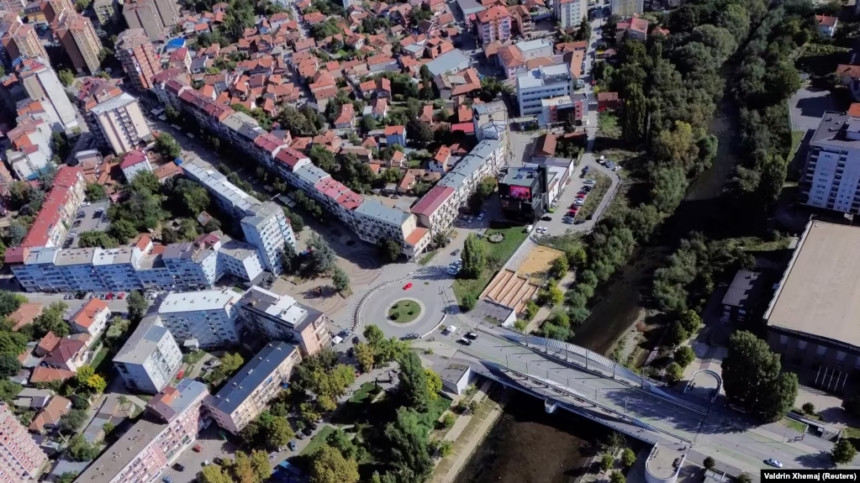The acting Government of Kosovo announced today that the construction of two new bridges on either side of the main bridge over the Ibar River will commence this afternoon, July 1. These bridges, according to the acting government, aim to connect North Mitrovica, predominantly inhabited by Serbs, with South Mitrovica, predominantly inhabited by Albanians.
The foundation stones for the two new bridges, one for vehicles and the other for pedestrians, will be laid on Tuesday at 5:00 PM. The event will be attended by acting Prime Minister Albin Kurti, North Mitrovica Mayor Erden Atiq, South Mitrovica Deputy Mayor Arian Tahiri, acting Minister of Local Government Administration and co-chair of the Joint Board of the two municipalities Elbert Krasniqi, and acting Minister of Environment, Spatial Planning, and Infrastructure Liburn Aliu.
Project Details and Government Stance on Main Bridge
The acting Government of Kosovo previously informed Radio Free Europe (RFE) that the bridge construction project was initiated at the request of the two municipalities, resulting from the creation of the Joint Board of Mitrovica. The memorandum of understanding, the statement noted, stipulates that the Ministry of Environment, Spatial Planning, and Infrastructure (MMPHI) will finance and implement these infrastructure projects – which include the construction of pedestrian and vehicle bridges over the Ibar River – with the aim of facilitating the freedom of movement for citizens and goods.
Regarding the possibility of opening the main bridge over the Ibar to vehicle traffic – a move that caused tensions last year – the Government emphasized that its position remains unchanged: “The main bridge over the Ibar must be open for full traffic, while the construction of the two new bridges will further contribute to the spirit of cooperation between the two municipalities and free movement on both sides of the Ibar River.”
International and Local Reactions
The European Union informed RFE that it is neither involved in nor informed about this project. According to the EU, any decision concerning infrastructure construction over the Ibar River must be made carefully and inclusively, fully involving all affected communities.
Dušan Milunović, a Serbian community councilor in the North Mitrovica Municipal Assembly, believes these new bridges are unnecessary. Milunović stated that the construction of these bridges “will negatively affect the general situation.” “If we had solved all the city’s problems, such as roads, sewage, infrastructure… If it were time to build bridges, I would understand. But, unfortunately, the situation on the ground is not like that,” he told RFE.
Skender Sadiku, Deputy Speaker of the North Mitrovica Municipal Assembly, expressed support for any bridge construction as they symbolize connections between people, cultures, and differences, but added that there are currently more pressing issues to address.
Background on Mitrovica Division and Bridge Status
The city of Mitrovica was divided in the post-war period and officially separated into two municipalities in 2013: South Mitrovica, predominantly Albanian, and North Mitrovica, predominantly Serbian. In mid-June 2025, a joint board for these two municipalities was formed, based on the Law on Administrative Boundaries of Municipalities, with the aim of “bringing citizens closer.”
Last summer, the Government of Kosovo initiated a move to open the main bridge over the Ibar to traffic – a decision opposed by the local Serb population and the international community. The NATO-led Kosovo Force (KFOR), whose soldiers are stationed at the main Ibar River bridge, stated at the time that any decision on opening the bridge must be made within the framework of the dialogue between Kosovo and Serbia, mediated by the European Union.
The then-U.S. Ambassador to Kosovo, Jeffrey Hovenier, told RFE that there was a real risk from opening the bridge in Mitrovica, which could affect the safety of NATO soldiers, including American troops. Kosovo’s Prime Minister Albin Kurti later stated that his Government would continue consultations and coordination regarding the bridge’s opening, emphasizing that this issue was not directed against anyone.
In 2014, Kosovo and Serbia agreed to open the bridge to traffic as part of the dialogue for normalizing relations. The so-called revitalization of the bridge was planned to remove all barricades erected by local Serbs and to functionalize the bridge. Subsequently, in 2016, a new implementation plan was approved, aiming to overcome disagreements over different interpretations of previous findings. According to the new implementation plan, the full opening of the bridge was supposed to take place in January 2017. Works on the bridge’s revitalization were completed only in June 2018, and the bridge, in which 1.5 million euros were invested, was never opened to vehicles, only to pedestrians.







